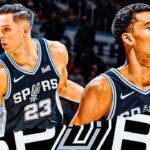The last time the basketball world caught a glimpse of a fully-realized Kawhi Leonard, he was almost singlehandedly kicking the Golden State Warriors’ ass. With a superior supporting cast to the 2016-17 San Antonio Spurs, the Toronto Raptors—with Leonard—could become the greatest threat the Kevin Durant-led Warriors have faced.
When the Warriors debuted their new super team for its first NBA regular season game, Kawhi Leonard sized them up and cut them down, scoring 35 points in the Spurs’ 129-120 season-opening win.
Later that season, in Game 1 of the 2017 Western Conference Finals, Leonard dominated again. The 2014 Finals MVP scored 26 points and pulled down eight rebounds to lead the Spurs to a 25-point lead before an injury took him out for the rest of the series.

A lot has changed since the Spurs’ 61-win 2016-17 campaign. The Houston Rockets added Chris Paul to James Harden and took the Warriors to seven games. The Boston Celtics traded for Kyrie Irving and signed Gordon Hayward, then made the Eastern Conference Finals after both missed the playoffs with injuries, getting star performances from Jayson Tatum and Jaylen Brown. The Philadelphia 76ers’ process yielded Joel Embiid and Ben Simmons as the most promising young superstar tandem in the NBA.
With so much upheaval across the league, and the gap between the Warriors and the rest of the NBA so large, it’s easy to forget those teams weren’t just chasing Golden State. San Antonio was the league’s second-best team with a gap between them and the Cleveland Cavaliers or Houston.
All with Kawhi Leonard as the lone superstar.
In no other sport is one team so transformed by the presence of one elite player as it is in basketball. The number of one-star championships—Hakeem Olajuwon’s 1994 Rockets, Tim Duncan’s 2003 Spurs, and Dirk Nowitzki’s 2011 Dallas Mavericks—are rare, but exist. There’s an advantage to having a player an opponent has no answer for. Plug one truly elite player into a well-constructed system of talented, two-way role players, sprinkle in some execution, and a team can topple giants.
And a healthy Leonard is the perfect answer to every trend the Warriors have helped spur. In a league moving towards switch-happy, versatile defenses designed to take away the beautiful ball movement the Spurs won with in 2014, and the Warriors have since perfected, Leonard is a one-man solution to all.
Golden State has elite defenders across four positions, all with varying body types and defensive skill sets. When he last faced them, Kawhi Leonard cooked them all.
Leonard’s strength, footwork, balance, and shooting touch are enough to negate Kevin Durant’s length by attacking his slenderer frame, as he does here:
Think about it, the Warriors have some of the best defensive players in the league and Kawhi Leonard absolutely cooked them all.
Remember when KD got DPOY buzz? He's not strong enough to guard Kawhi. Here's a small bump that creates separation for his pull-up jumper. pic.twitter.com/XPPFWSt8uP
— Jesse Blanchard (@blanchardJRB) July 18, 2018
That season was the first Kawhi mastered his specific type of athleticism—which combines the greatest balance in the league with plus strength for his position—and married it to a rich, diverse skill set.
Matched up with, perhaps, the second-best perimeter defender in the league, all Leonard needed was a screen to shake free from Andre Iguodala:
Andre Iguodala was your Finals MVP for 'slowing' LeBron, and Kawhi just sets him up with a screen and loses him like it's nothing. pic.twitter.com/b5NPOYVfOW
— Jesse Blanchard (@blanchardJRB) July 18, 2018
Even Draymond Green, who might be the most versatile defensive player in NBA history, struggled to contain Leonard at his peak.
Draymond Green was a DPOY, but there's not really an answer for an elite shooter with explosive ability and good footwork. pic.twitter.com/p7pwM7g2nh
— Jesse Blanchard (@blanchardJRB) July 18, 2018
More importantly, the game slowed down for Leonard. Watch him here as he snakes the pick-and-roll, cutting in front of a defender and keeping him on his back while he moves at his own pace:
And this is some Chris Paul stuff…snaking the PnR, keeping a defender on his back, then getting into the body of the rim protector and finishing strong. pic.twitter.com/S93aeXYnNH
— Jesse Blanchard (@blanchardJRB) July 18, 2018
Chris Paul was able to use this tactic to befuddle Golden State at times and Leonard has vastly superior physical advantages. This is the type of play, being quick but never hurrying, that unlocks the sort of reads and manipulation of defenses that helps a player make his teammates better.
The difference between Leonard and, say, James Harden or Russell Westbrook, is his size, type of athleticism, and shooting give him a wider range of matchups he can physically dominate. His ability and willingness to work off the ball, away from the defense’s attention but never far from its mind, also works in his favor:
Also, unlike the past two MVP guards, Kawhi's off-ball movement opens up all sorts of problems for defenses. pic.twitter.com/jSl7GxghDl
— Jesse Blanchard (@blanchardJRB) July 18, 2018
If Kawhi Leonard isn’t the best player in the NBA on any random night, he’s often the best player on every court he steps on—if only because, unlike his opponents, he won’t have a Kawhi Leonard guarding him to contend with.
San Antonio leveraged this to punch above its talent level, with Gregg Popovich devising a system to best maximize his strengths and allow others to play off him. There were no good options for dealing with Leonard and the Spurs had the means and execution to punish most teams based on which bad option they picked.
Like the Spurs, last year’s Raptors were a team greater than the sum of its parts. New Head Coach Nick Nurse, then Toronto’s assistant under Dwane Casey, devised an offense that reduced its star players burdens by empowering the role players to make decisions, allowing Kyle Lowry and DeRozan to come in and out of a defense’s focus to their advantage. This created a positive feedback loop making life easier for Toronto’s more offensively limited role players.
The value of this is it allowed the Raptors to field lineups with defensive personnel like OG Anunoby and Pascal Siakam.
Only LeBron James really managed to completely unravel the seams tying the Raptors’ together. Toronto could never beat the league’s best player. Now, presuming health, they have the best player in the Eastern Conference.

In 2017, Leonard proved to be enough to cause the Warriors all sorts of problems. And here’s the thing: these Raptors probably have a better supporting cast.
Last year’s Raptors were the fifth-best defense, ranked one spot behind the Spurs. In addition to Leonard, they added Danny Green, who might be the perfect wing pairing with Kawhi. Green is a low usage player who can space the floor and defend across both backcourt positions and a few slighter forwards. Since 2012, Green and Kawhi have practically been a top five defense unto themselves.
It was Green and Leonard who originally showed the effectiveness of a switching defense to counter the Stephen Curry-Draymond Green pick-and-rolls with both players able to competently defend either, along with Durant, to the extent any of them can be guarded.
Throw in lineups with those two, Anunoby, Siakam, and whatever remains of the life in Serge Ibaka’s legs, and the Raptors have the sort of long, rangy, mobile defensive lineups San Antonio lacked. The Raptors also shed their worst perimeter defender while upgrading their offense in swapping DeRozan for Leonard.
Like Westbrook's Oklahoma City Thunder, Leonard's presence on the Raptors allows Nurse to field lineups heavy on defense and short on shot creation; only with Leonard as a more efficient player. Unlike the Thunder, the Raptors can do so without completely killing their floor spacing.

In the backcourt, Lowry and Fred VanVleet are massive upgrades to the Tony Parker, Patty Mills, and Dejounte Murray point guard by committee the Spurs ran out then.
Last season, Lowry learned how to scale back his usage to better share playmaking responsibilities, getting more out of fewer touches to craft a more impactful game. He can work off the ball, or as a team’s primary creator. And Leonard’s size, shooting, and ability to post opens two-man actions Lowry never had with DeRozan.
VanVleet and Delon Wright helped to lead a Spurs-ian bench, giving the Raptors a myriad of situational skill sets and players to fit around their star backcourt.
Jonas Valanciunas is no LaMarcus Aldridge, but he's a big body near the rim with some offensive utility and some burgeoning stretch to his shooting range. Ibaka may no longer be what he was in 2015 but he's still far more equipped to contribute against Golden State than Pau Gasol or David Lee were.
Granted, Toronto lacks the sheer amount of top-end talent a team like the Celtics possesses. But for all the firepower Boston has, it lacks—for now—the silver bullet the Raptors have loaded in the chamber. In basketball, one elite player can make all the difference. Now, the Raptors have one year to prove they can keep him.




